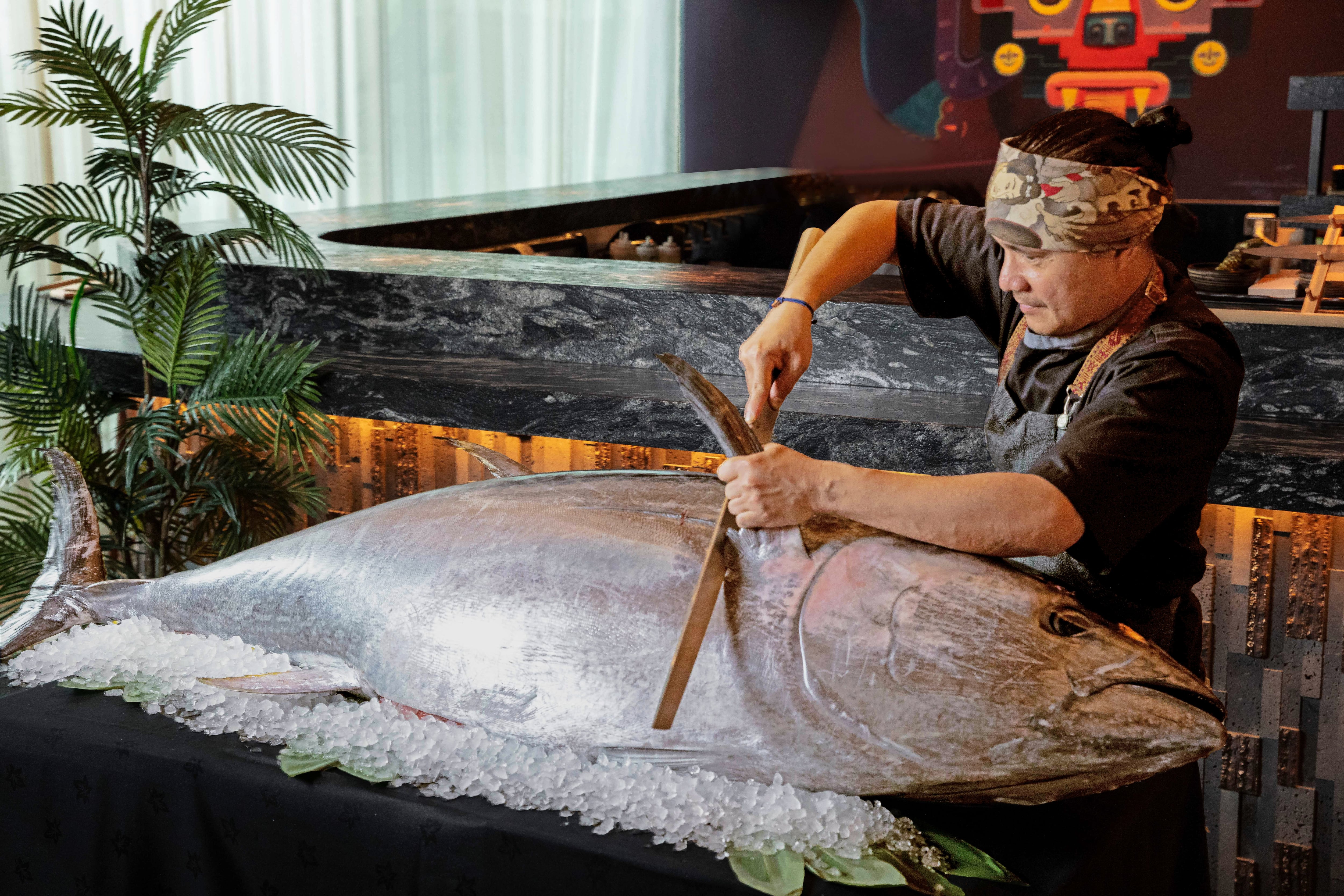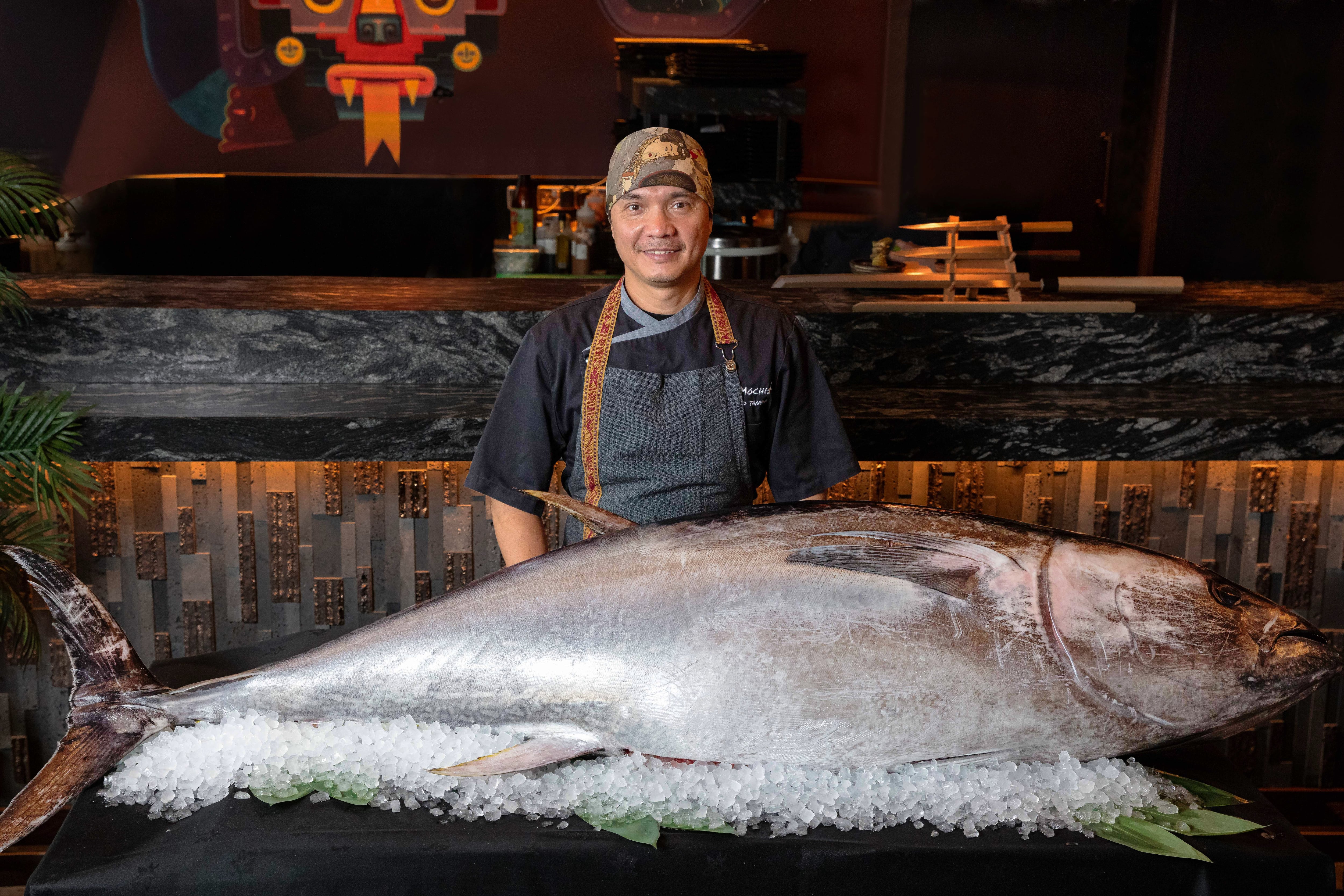A tuna ceremony… guessing this isn’t the sort of stuff you’d find in a can then?
It couldn’t be further from it. We’re talking about bluefin tuna, specifically Atlantic bluefin, which is the largest species of tuna in the world.
Impressive. Why isn’t it something we’ve seen more commonly on menus in the past?
For years, indeed for much of this writer’s life, Atlantic bluefin tuna has been considered endangered, having been listed as such back in 1996 following decades of overfishing. However, it was reclassified in 2021 as being a species of ‘least concern’ by the International Union for Conservation of Nature (IUCN). It was also subsequently removed from the Marine Conservation Society’s Good Fish Guide red rated Fish to Avoid list and rated amber for the first time.
And so now we’re starting to see this fishy served on a dishy
We certainly are. James Lowe, the chef-patron of Lyle’s in London’s Shoreditch, told Restaurant last year that the new fishing licences granted for bluefin tuna was ‘one of the most exciting moments in British food for years’. This attitude is shared by others in the industry, not least Markus Thesleff, owner of Mexican-Japanese restaurant group Los Mochis in London, who has launched TENrei, a twice-monthly ceremony held at its London City restaurant that sees a whole bluefin tuna broken down in front of guests using traditional Japanese knives before being served across a 10-course tasting menu.
Sounds a bit savage…
It’s probably not one for the squeamish. A video posted by Hot Dinners (see below), which attended one of the ceremonies in January, shows the 220kg fish being wheeled out on a large trolley before being butchered. Guests even have the opportunity to scoop up some of the tuna meat and eat it straight from the carcass as an amuse-bouche before the dinner.
What’s the idea behind it then?
Thesleff tells Restaurant that the TENrei ceremony is about ‘connecting and educating diners with the origins of their food, celebrating the heritage of Japanese traditions, and fostering a greater appreciation for sustainable sourcing’. “At Los Mochis, we were already using a whole Bluefin tuna each week, but the process of breaking it down was happening behind the scenes,” he says. “Previously, chefs would travel over an hour to our supplier, spend several hours cutting up the fish, and then have it delivered chilled to the restaurant. When we reflected on this, it felt like a missed opportunity – not only because of the logistical inefficiencies, but also because it meant guests never saw or fully appreciated the craftsmanship and tradition behind preparing such a magnificent fish. By witnessing the breakdown process firsthand and then tasting the variety of textures and flavours that each part of the fish has to offer, guests gain a deeper understanding of what they’re eating and why responsible sourcing matters.”
How have diners responded?
Leonard Tanyag, executive chef for Los Mochis, admits that some diners have had reservations, although this is primarily focused on the sourcing of the product than the ceremony of it being cut up in front of guests. “Sustainability is at the heart of TENrei, and we understand that bluefin tuna has long been a contentious issue. Historically, overfishing led to concerns about the species’ survival, but responsible and regulated practices have made sustainable bluefin sourcing a reality,” he says. Los Mochis sources its tuna from Balfegó, a family-run company in Spain that’s B Corp certified and, according to Tanyag, works closely with international bodies like ICCAT and Spanish research institutions to ensure that their fishing quotas, monitoring systems, and traceability protocols align with forward-thinking sustainability practices. “Transparency is key,” he continues. “By educating guests on the responsible fishing methods and environmental efforts behind Balfegó’s work, we help them feel confident in the sustainability of what they’re eating. TENrei is not just about showcasing the quality of Bluefin tuna; it’s about demonstrating that it can be enjoyed ethically when sourced from the right suppliers.”

Is Los Mochis the only restaurant to offer this sort of experience?
It’s not. Urchin in Holland Park is another example in the capital. It hosts a weekly ‘Tuna Fight Club’, which is described as an ‘interactive immersion into Atlantic bluefin tuna with a unique tasting menu’ that’s created by the restaurant’s head chef, Yuji Shimokawa. Others to have held similar events include Spanish chef José Pizarro, who hosted a special ‘ronqueo’ dinner last year that similarly involved a demonstration of the butchering process, the word ronqueo’ referring to a Spanish tradition of freshly caught tuna being skinned and filleted by hand. The term, according to Pizarro, is derived from the knife’s noise when it rubs against the backbone.
Are there any places outside of the capital doing something similar?
There are certainly more restaurants exploring the possibilities of bluefin tuna as an ingredient, even if they’re not hosting special events like those mentioned above. Last year, the newly Michelin-starred Wilson’s in Bristol decided to order a whole tuna as something of an experiment. “I’d never done it before, and neither had my chefs,” says Jan Ostle, the restaurant’s head chef and co-founder. “We’d served tuna on the menu, but never received a whole fish before.”
Was it worth it?
Ostle describes the process of butchering the fish with his team as a ‘nice collaborative experience’ and enjoyed using different parts of the fish for different dishes. The head meat, for example, was minced and used to make tuna koftas; the eyes were used to make Josh Niland’s fisheye ice cream, which sounds like something you might get served in I’m a Celebrity. However, Ostle has no plans to order a whole bluefin tuna again any time soon. “I don’t think I’d do it again, but it was a cool thing for us all to experience together,” he says. “I wish I’d had a bit more experience and tutorage with it, as I’ve never butchered one before. But I think we did it proud.”


